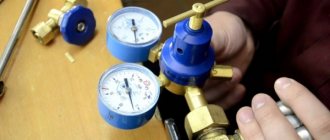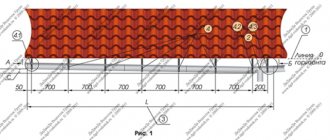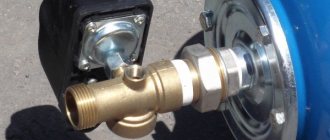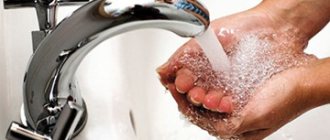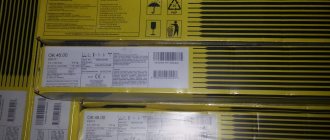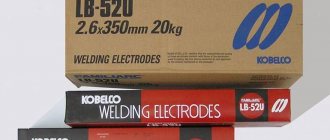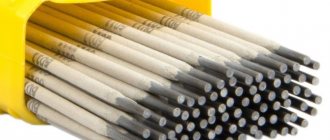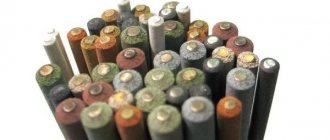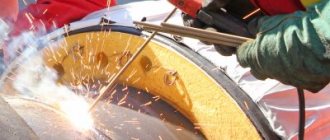Home / Electrodes
Back
Reading time: 3 min
0
687
Many welders are interested in the question: “How much does one electrode weigh?” And for good reason. This indicator is very important for the selection of materials. Knowing reliable information, you will be able to avoid deception, but also choose rods with the required weight.
These indicators greatly influence the outcome of welding work, and also the condition of the finished joints. But don’t forget about the coating, diameter and condition of the products.
Our article will discuss the weight of a pack and a single electrode. You will find out how many parts are put in a single pack. With this information you will be protected.
- A short introduction
- Number of anticathodes
- Anticathode weight
- Let's sum it up
A short introduction
Let's start with the fact that the electrode is considered almost the main mechanism in welding work. Even wires and protective gases fade into the background.
Using RDS welding technology, you can easily carry out repairs or weld different elements. Your arsenal should only include a portable inverter and a pack of electrodes. Manual arch welding can be so easy!
Simplicity is not always good when it comes to the quality of seams and the need to select the right components. If the brand is chosen incorrectly, all your efforts will be in vain.
To choose a good mesh, you need to know its composition and basic parameters.
In the 21st century, you have dozens of types of mechanisms with their own characteristics at your disposal. But physical quantities play a primary role. Especially when you are interested in wholesale purchases of parts.
Retail chains sell welding rods in individual packages, and small stores are interested in individual sales. When the weight of materials is known, it is convenient for both the buyer and the seller.
You will be able to buy the required number of parts in a few minutes.
But sometimes it happens that the store tries to deceive you. To avoid such situations, it is important to carefully understand this issue. We will tell you how many electrodes are sold in packs and what their weight is.
Electrode consumption, norms, tables, how to calculate
An important part of any production or construction process is accurate and competent planning of material consumption, which is carried out to draw up estimates and calculate financial costs.
When erecting metal structures by welding, it is important to know not only the metal consumption, but also the required number of electrodes. A correctly performed calculation will allow you to find out the exact cost of the work, and the welding process will be carried out according to plan. It should be noted that calculating the consumption of welding electrodes is relevant and in demand only during the construction of large facilities . The large scale of work requires an accurate determination of the volume of materials, which will be included in the construction estimate. For this purpose, the concept of “electrode consumption per 1 ton of metal structures” was introduced.
Number of anticathodes
The number of electrodes in the package largely depends on the manufacturer.
Why does the number of parts play a big role during the purchase? This is logical: the number affects the weight of the package and the number of mechanisms in it. The more parts in the pack, the larger the container.
If we talk about the quantity parameter, the following formula works here: the larger the diameter and length of the material, the fewer pieces in the package.
Are you a regular shopper? Then you don't have to think about these moments. This data will be useful for wholesale buyers, for whom the number of electrodes and their total weight are important.
Undoubtedly, information is of great importance if the number of mechanisms is 100 or more.
Take note of the table in which you will see the exact number of electrodes in a pack of type UONI-13/55. Please take into account the fact that we indicated average values, which in practice differ from each manufacturer.
Speaking about other companies, the number of mechanisms in such packs is not easy to determine. The indicator is influenced by more than one factor: the shape, length, and diameter of the parts.
They are different for each individual marking. It is impossible to calculate even approximate indicators. There is only one way out: carefully study the packaging before purchasing.
Pack weight depending on brand and manufacturer
Examples include weighing scales from the following brands and manufacturers:
| Brand | Manufacturing plant | Diameter, mm | Box weight, kg |
| OK 46.00 | ESAB-SVEL | 3,5 | 5,3 |
| 4 | 6,6 | ||
| SE-46 | Tyumen | 3 | 5 |
| 4 | 6 | ||
| 5 | 5,5 | ||
| UONII-13/55R | ESAB-SVEL | 3 | 4,5 |
| 4 | 6,0 |
Anticathode weight
Please take into account the fact that the mass of an individual electrode may vary depending on the batch. Even in a situation where the manufacturer of the material is the same brand.
These indicators are affected by the volume of coating that covers all electrodes. The process is not always neat and uniform. The error is small. Underweight or overweight of one is approximately 1-2 grams.
The weight of the entire package and the number of electrodes that fit into the conventional weight framework are also taken into account. This indicator is no different in 9 cases out of 10.
If you want to find out the weight of an individual part, divide the weight of the package by the number of parts indicated on the pack. You will know the approximate weight, taking into account minor errors. Remember that diameter often affects the weight of the electrodes.
Standard electrode weight
The current GOST provides standards for filler, thickness, and other parameters of the rod for welding. Moreover, the weight of one electrode of the same size is not always identical. The standard error is 1-2 g. The main parameter is the weight of the package.
The indicator of one element is calculated by the formula: the mass of the box is divided by the number of rods placed in it. This rule does not work for artisanal and dubious manufacturers.
3 mm
The weight of a pack of electrodes, regardless of manufacturer brands, differs in different batches. This depends on the amount of coating that is applied in an uneven layer. The weight is affected by the size of the rod; modifications of 2.5 and 4 mm will be 5 mm lighter than their counterparts. One electrode with a diameter of 3 mm weighs 26.4 g (the error in both directions does not exceed 2 g).
4 mm
It should be taken into account that if the pack says 5 kg, in fact the weight will be less. If the indicator is reduced by several tens of grams, this is a clear underweight. Unscrupulous sellers often take several electrodes out of the packages, selling them individually, increasing profits. In this regard, the product should be purchased from official representatives or trusted retail outlets.
For example, the weight of a 4 mm rod is nominally up to 59.9 g, and a 5 mm rod is already from 83 to 95 g.
Let's sum it up
We talked about the main points that are worth knowing about the number of electrodes in a pack and their weight. The parameters are quite accurate, but they may differ depending on the brand parameters.
Once you have been in business for more than one year, you will be able to easily buy parts and not worry about being scammed. Being able to determine the weight of electrodes “by eye” is useful.
More practice is needed in this matter. You should not miss this, because you will be able to avoid significant overpayments.
Have you ever been deceived in such cases? What principles or techniques do you use to select electrodes? Share your opinion in the comments! Enjoy the shopping.
Number of electrodes depending on diameter
Taking into account the overall dimensions of the box and restrictions on the weight of the package, the number of rods corresponds to the following tabular data:
| Diameter, mm | Length, m | Weight, g | Quantity per pack, pcs. | Total package weight, kg |
| 3 | 350 | 26,5 | 95 | 3 |
| 4 | 450 | 60 | 82 | 5 |
| 5 | 450 | 95 | 52 | 5 |
Flaws
- The connection obtained by welding is characterized by high strength.
- The arc is distinguished by easy ignition and combustion stability, especially at low current strength.
- Re-ignition is achieved without difficulty.
- The resulting seam has no joints, it is even and has a good presentation.
- There are no pronounced transition zones between the weld metal and the part.
- Thanks to the rutile type of coating, the seam is reliably protected from slag and oxidation.
- The electrode is characterized by very little metal spattering.
- The work is characterized by high productivity.
- MP-3 is equally suitable for both welding and tack welding.
- Relatively high price - the cost of this consumable is slightly higher than many other electrodes.
- The impossibility of welding vertically from top to bottom - however, many other brands cannot “boast” of this.
- Not the lowest material consumption - 1.7 kg per 1 kg of seam (MR-3R has slightly less - 1.62 kg).
- During the welding process, the electrode must be held at an acute angle relative to the surface being made. If you weld at a right angle, a large amount of slag will inevitably be released, which will penetrate into the seam.
- It is extremely important to set the required current strength - otherwise there is a risk of pores forming in the weld metal.
And one more feature - intermittent sutures must be applied quickly enough, which requires certain skills. However, even beginners can master this technique in a short time, without much experience or special education.
How many electrodes are in a pack?
Reading time: 4 minutes
Electrode weight is not just a formal characteristic that is needed by sellers and buyers. This is an important property on which the quality of the finished welds can depend. Yes, the quality is largely influenced by the composition of the electrode, its coating and diameter. But weight also contributes to the final result of welding work.
From that article you will learn how much a pack and one electrode weigh, how many pieces of electrodes are in a standard pack. Knowing this information, you will not be deceived when purchasing and will be able to select rods with the optimal weight.
Application of MP 3 electrodes
Electrodes are widely used in the installation of critical structures made of low-alloy steels, when increased strength of connections is required. Areas of use:
- welding pipes during pipeline installation, creating non-rotating pipe joints;
- welding, repair of tanks operated under high pressure conditions;
- shipbuilding;
- mechanical engineering.
Electrode pack weight
According to clause 6.3. GOST 9466-75 the mass of electrodes in a pack should not exceed:
GOST 9466-75 also regulates the permissible deviation of the mass of electrodes in a box or pack. According to the document, the deviation of the mass from that indicated on the packaging should not exceed half the calculated mass of one electrode in the direction of decrease and the calculated mass of two electrodes in the direction of increase.
Our products are packaged in accordance with GOST requirements. Electrodes with diameters ranging from 3 mm, 4 mm, 5 mm and 6 mm are packed in 5 kg cardboard boxes (more detailed information can be found in the article “ Packaging of electrodes ”)
Weight of 1 electrode
Very often, to determine the need for electrodes, responsible persons resort to calculating the consumption of electrodes in pieces per 1 running m of seam. This method allows you to control the individual consumption of electrodes.
As is known, the mass of one electrode is influenced by parameters such as diameter, length, type of coating and other factors. For example, let’s look at the features of calculating the mass of electrodes for welding of the UONI brand. The mass of a pack of electrodes UONI-13/55 type E50A is 5 kilograms, the length of the welding electrode for diameters 3 mm, 4 mm, 5 mm and 6 mm is 450 mm, the coating is thick. For this brand with its own characteristics, the following calculated quantities and weights:
Number of electrodes in a pack
For diameter 3 mm – 156 pcs.
For diameter 4 mm – 88 pcs.
For diameter 5 mm – 54 pcs.
Weight of one electrode
For a diameter of 3 mm – 32 grams
For a diameter of 4 mm – 56.8 grams
For a diameter of 5 mm – 92.5 grams
It is worth noting that the parameters for the number of pieces of electrodes in one pack and the weight of one electrode are different for each brand of electrodes, since different materials are used in the production of these brands.
For foreign manufacturers with their standards for nominal electrode diameters, the weight of one electrode is slightly different. Consider, for example, the Japanese electrodes LB-52U and the Swedish electrodes KO 53.70 , these electrodes correspond to the Russian UONI-13/55 electrodes in type and coating.
Number of pieces in a pack and weight of one LB-52U electrode:
Diameter KO 53.70 (mm)

